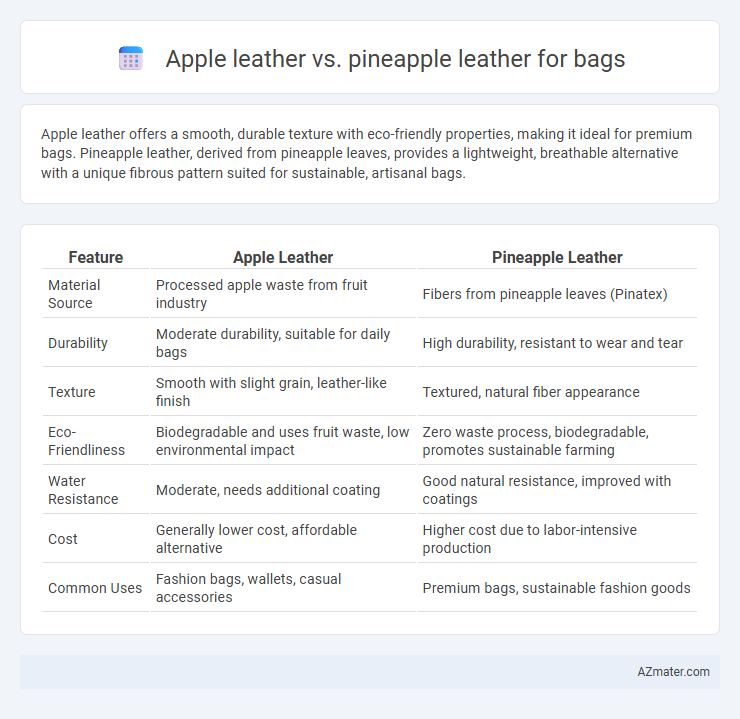Apple leather offers a smooth, durable texture with eco-friendly properties, making it ideal for premium bags. Pineapple leather, derived from pineapple leaves, provides a lightweight, breathable alternative with a unique fibrous pattern suited for sustainable, artisanal bags.
Table of Comparison
| Feature | Apple Leather | Pineapple Leather |
|---|---|---|
| Material Source | Processed apple waste from fruit industry | Fibers from pineapple leaves (Pinatex) |
| Durability | Moderate durability, suitable for daily bags | High durability, resistant to wear and tear |
| Texture | Smooth with slight grain, leather-like finish | Textured, natural fiber appearance |
| Eco-Friendliness | Biodegradable and uses fruit waste, low environmental impact | Zero waste process, biodegradable, promotes sustainable farming |
| Water Resistance | Moderate, needs additional coating | Good natural resistance, improved with coatings |
| Cost | Generally lower cost, affordable alternative | Higher cost due to labor-intensive production |
| Common Uses | Fashion bags, wallets, casual accessories | Premium bags, sustainable fashion goods |
Introduction to Plant-Based Leathers
Plant-based leathers such as Apple leather and Pineapple leather represent sustainable alternatives to traditional animal leather, crafted from renewable agricultural waste. Apple leather derives from apple peels and cores, offering a biodegradable, soft texture ideal for eco-friendly bags. Pineapple leather, known as Pinatex, utilizes pineapple leaf fibers to create a durable, breathable material with minimal environmental impact.
What is Apple Leather?
Apple leather is an innovative vegan material made from the discarded apple peels and cores leftover from the fruit juice industry, offering an eco-friendly alternative to traditional leather. Its durability, breathability, and natural texture make it a popular choice for sustainable fashion accessories like bags. Compared to pineapple leather, apple leather tends to have a softer feel and a more uniform surface, appealing to consumers seeking cruelty-free and biodegradable options.
What is Pineapple Leather?
Pineapple leather, also known as Pinatex, is an innovative sustainable material made from the cellulose fibers of pineapple leaves, offering an eco-friendly alternative to traditional leather. Unlike Apple leather, which is derived from apple peel waste, pineapple leather provides a durable, breathable texture ideal for bags and fashion accessories. This plant-based material reduces agricultural waste and supports circular fashion by utilizing byproducts typically discarded in pineapple farming.
Production Processes Compared
Apple leather is produced using waste from the apple juice industry, involving the drying, grinding, and blending of apple peels and cores with a polyurethane base, resulting in a durable yet eco-friendly material. Pineapple leather, or Pinatex, is crafted from pineapple leaf fibers, which are extracted, dried, and felted into a non-woven mesh before being combined with a resin coating to form a sustainable leather alternative. Both processes prioritize waste valorization, but apple leather relies on fruit byproducts while pineapple leather upcycles agricultural residue, influencing texture and environmental impact.
Environmental Impact
Apple leather, derived from apple waste, reduces agricultural byproducts and requires less water and pesticides compared to traditional leather, lowering its environmental footprint. Pineapple leather, made from pineapple leaves, utilizes agricultural residue that would otherwise be discarded, promoting waste valorization and reducing landfill contribution. Both materials offer sustainable alternatives by minimizing resource consumption and supporting circular economy principles in the fashion industry.
Durability and Performance
Apple leather offers moderate durability with a soft texture that resists scratches and stretches well but may show wear over time under heavy use. Pineapple leather, made from robust pineapple leaf fibers, provides superior tensile strength and better resistance to water and abrasion, making it highly suited for long-lasting bags. Both materials provide eco-friendly alternatives to traditional leather, but pineapple leather generally outperforms apple leather in durability and overall bag performance.
Texture and Aesthetic Differences
Apple leather features a smooth, consistent texture with a matte finish that mimics traditional leather, offering a sleek and polished aesthetic ideal for luxury bags. Pineapple leather, often derived from Pinatex, exhibits a more fibrous surface with subtle natural grain patterns, providing a unique, eco-friendly look emphasizing rustic and artisanal qualities. The tactile difference is prominent, with apple leather feeling more uniform and supple, while pineapple leather delivers a slightly rougher, textured touch that enhances visual depth and character.
Cost and Accessibility
Apple leather bags typically cost more due to the processing required to transform apple waste into durable material, whereas pineapple leather, made from pineapple leaf fibers, tends to be more affordable and widely accessible. Pineapple leather benefits from abundant agricultural byproducts and a simpler production process, contributing to its lower price point in the market. Both materials offer eco-friendly alternatives to traditional leather, but pineapple leather is generally easier to source and purchase at competitive prices.
Sustainability and Ethical Considerations
Apple leather offers a biodegradable and cruelty-free alternative made from apple waste, reducing agricultural byproducts while minimizing environmental impact. Pineapple leather, derived from pineapple leaf fibers, promotes zero-waste practices by utilizing agricultural leftovers and supports local farming communities through ethical sourcing. Both materials provide sustainable, animal-free options with lower carbon footprints compared to conventional leather.
Which is Better for Bags?
Apple leather offers a smooth texture and high durability, making it ideal for daily-use bags that require flexibility and resistance to wear. Pineapple leather features a unique, highly breathable structure with eco-friendly qualities, suited for lightweight, stylish bags with a natural aesthetic. When choosing which is better for bags, apple leather excels in strength and longevity, whereas pineapple leather prioritizes sustainability and a distinct look.

Infographic: Apple leather vs Pineapple leather for Bag
 azmater.com
azmater.com